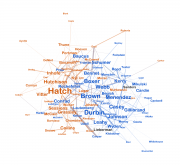
The word “government” conjures the image of hierarchy and well arranged organizational charges. The reality of governing, however, is far messier—of interdependent agencies and decision makers arrayed around a complex array of problems. “Networked governance” is meant to evoke this reality of distributed authority and interlocked problems.
My own research has focused on the informational dimensions of governance—how the information produced by some actors in a system might produce positive externalities for others. Thus, for example, my research has examined how DNA laboratories—which are dispersed geographically and institutionally—wrestle with common issues around rapidly evolving technology. Similarly, other research has examined the extent to which communications directors in the offices of Members of Congress share their knowledge with each other (not very much as it turns out!), and State Health Officials (the lead official in each state for health related policy) share their experiences.
